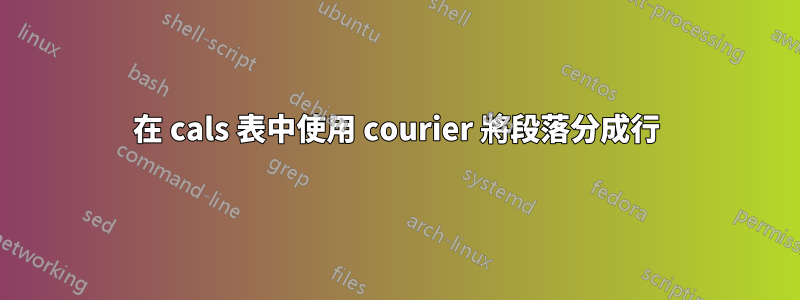
\documentclass[10pt,a4paper]{article}
\usepackage[utf8]{inputenc}
\usepackage[a4paper]{geometry}
\geometry{top=10mm, bottom=10mm, left=10mm, right=10mm}
\geometry{showframe}
\usepackage{courier}
\usepackage[T1]{fontenc}
\usepackage{cals}
\makeatletter
\begin{document}
%\renewcommand*\familydefault{\sfdefault}
\renewcommand*\familydefault{\ttdefault}
\normalfont
\begin{calstable}
\colwidths{
{15pt}
{10pt}
{515.60239pt}
}
\cals@paddingL=1pt
\cals@paddingR=1pt
\def\cals@borderT{0.2pt}
\def\cals@borderB{0.2pt}
\def\cals@borderL{0.2pt}
\def\cals@borderR{0.2pt}
\brow
\alignR \cell{\strut E}
\alignC \cell{\strut =}
\alignL \cell{\strut this is the english text, this is the english text, this is the english text, this is the english text, this is the english text, this is the english text, this is the english text}
\erow
\end{calstable}
Why doesn't the text break in the rigth place? In case of using sfdeault, it's good.
\end{document}
答案1
這類似於如何打破長 \texttt 部分。預設情況下,tt字體沒有可拉伸的字間空間,因此 TeX 在選擇換行符時沒有太多的操作空間。添加一些拉伸性可以改善斷線:

\documentclass[10pt,a4paper]{article}
\usepackage[utf8]{inputenc}
\usepackage[a4paper]{geometry}
\geometry{top=10mm, bottom=10mm, left=10mm, right=10mm}
\geometry{showframe}
\usepackage{courier}
\usepackage[T1]{fontenc}
\usepackage{cals}
\makeatletter
\newcommand*\flextt{%
\ttfamily
\fontdimen2\font=0.4em% interword space
\fontdimen3\font=0.2em% interword stretch
\fontdimen4\font=0.1em% interword shrink
\fontdimen7\font=0.1em% extra space
}
\begin{document}
\flextt
\begin{calstable}
\colwidths{
{15pt}
{10pt}
{515.60239pt}
}
\cals@paddingL=1pt
\cals@paddingR=1pt
\def\cals@borderT{0.2pt}
\def\cals@borderB{0.2pt}
\def\cals@borderL{0.2pt}
\def\cals@borderR{0.2pt}
\brow
\alignR \cell{\strut E}
\alignC \cell{\strut =}
\alignL \cell{\strut this is the english text, this is the english text, this is the english text, this is the english text, this is the english text, this is the english text, this is the english text}
\erow
\end{calstable}
Why doesn't the text break in the rigth place? In case of using sfdeault, it's good.
\end{document}
答案2
試圖打破字體中的單字總是一件大事tt。
您可以嘗試使用sloppypar環境:
\documentclass[10pt,a4paper]{article}
\usepackage[utf8]{inputenc}
\usepackage[a4paper]{geometry}
\geometry{top=10mm, bottom=10mm, left=10mm, right=10mm}
\geometry{showframe}
\usepackage{courier}
\usepackage[T1]{fontenc}
\usepackage{cals}
\makeatletter
\begin{document}
%\renewcommand*\familydefault{\sfdefault}
\renewcommand*\familydefault{\ttdefault}
\normalfont
\begin{calstable}
\colwidths{
{15pt}
{10pt}
{515.50239pt}
}
\cals@paddingL=1pt
\cals@paddingR=1pt
\def\cals@borderT{0.2pt}
\def\cals@borderB{0.2pt}
\def\cals@borderL{0.2pt}
\def\cals@borderR{0.2pt}
\brow
\alignR \cell{\strut E}
\alignC \cell{\strut =}
\alignL \cell{\begin{sloppypar}\strut this is the english text, this is the english text,
this is the english text, this is the english text, this is the english text,
this is the english text, this is the english text\end{sloppypar}}
\erow
\end{calstable}
Why doesn't the text break in the rigth place? In case of using sfdeault, it's good.
\end{document}
輸出:



